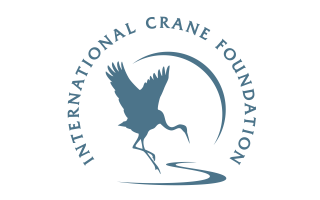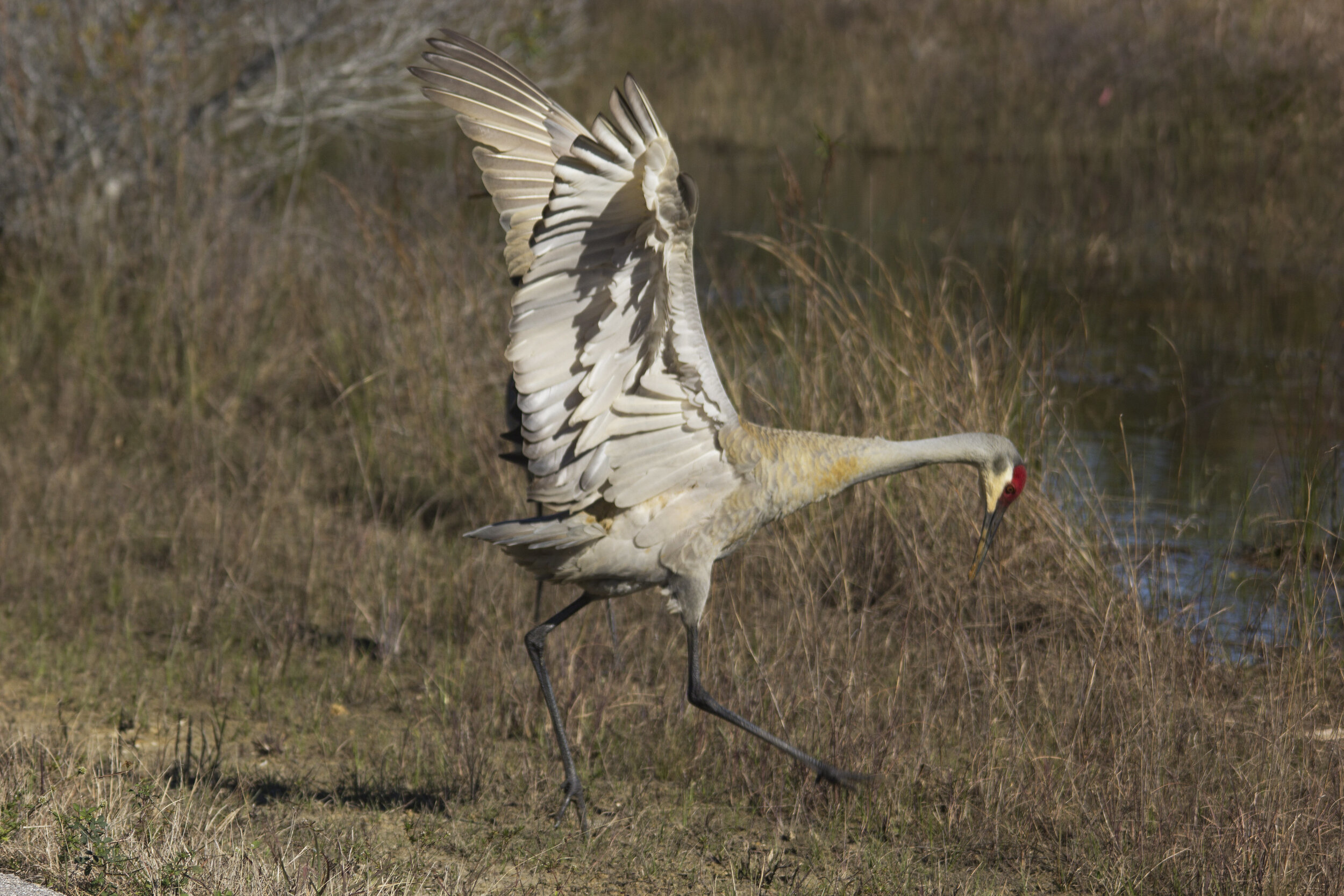Dancing like a Crane
This lesson was created by the education staff at International Crane Foundation and edited by Madison Audubon Staff.
Dancing to communicate
All animals, including humans, have ways of communicating with one another. Animal communication can be simple or complex, it can be intentional (on purpose) or unintentional (accidental), it can be vocal or silent. Many animals have more than one way of communicating – like humans.
Image description: the International Crane Foundation logo. The blue silhouette of a crane dancing is in the center of the image, it flutters above the suggestion of water and in front of the suggestion of a sun. The words “International Crane Foundation” arch over the image, encircling it.
Humans often communicate using voices, but we also have other ways of communicating, like facial expressions and body language. Think about how you know someone is happy or angry before they say anything. Their body and face tell you!
Humans are not the only animals to communicate using body language. Animals use body language to communicate amongst themselves, to other animals, and even to humans. A deer that stands still with pricked-up ears might be signaling to other deer that a predator is approaching. A pet dog might wag its tail in excitement when its owner approaches.
Like most other animals, cranes use body language to express how they are feeling. They do this by dancing. Sandhill Cranes are our most common cranes in Wisconsin. They have a bright red patch of feathers on top of their heads that makes their heads really visible while they’re dancing. All crane species dance, which is one of the reasons why they are beloved by and important to cultures around the world. Cranes dance for three primary reasons: 1. To find a mate; 2. To strengthen the bond between a mated pair; and 3. To express aggression or territoriality.
Image description: Two adult sandhill cranes dance together. Both have their wings outstretched and their heads up, the crane on the left is standing on the ground while the one on the right is lifted off of the ground about a foot. Image by Jen Goellnitz, Flickr Creative Commons.
Image Description: An adult Sandhill Crane rushes forward, wings held high above their body, head outstretched in front of them with their red forehead patch facing forward. Image by Dennis Church, Flickr Creative Commons
Get Dancing!
It’s your turn to dance like a crane! Please see the Crane Behaviors and Crane Dances guide (image right) to learn about the different crane behaviors and the different ways that they communicate with their bodies.
Go through each of the behaviors and act them out as if you were a crane
Read the story (below), Why Crane Has Long Legs and a Red Crown. Find someone to read the story to and put on a play by acting as the characters. For crane, add in parts to the story that include crane behaviors and crane dances.
Make your own play with crane behaviors and dance moves. Try to include at least 5 different behaviors or dance moves into your play.
Write your story
Practice your play
Put on your show for your family or friends
Image description: Simple ink drawings of cranes performing different actions. At the top are two cranes “head bobbing”: cranes take turns raising their heads high and lowering them to the ground. There are pairs of cranes wing flapping, jumping, and bowing. The last image is of “twig tossing”, where one crane picks up a twig from the ground and tosses it into the air. Image provided by ICF
Why Crane Has Long Legs and a Red Crown
A Cree Tale
Once, long ago, Rabbit thought it would be nice to go to the moon to have a look around. But how would he get there? He would need the help of someone who could fly. Rabbit asked all the large birds, one at a time, to fly him to the moon. He asked Hawk. He asked Eagle. Hawk was too busy, and Eagle said he couldn’t fly that high. Overhearing the conversation, Crane offered to fly Rabbit to the moon. Crane knew he could fly higher than the other birds. Rabbit held tightly to Crane’s legs and up they went toward the moon. Rabbit became heavier and heavier to Crane as he flew upward and his legs began to stretch longer and longer. The physical effort to fly Rabbit to the moon was tiring Crane and his head turned bright red. Finally, they reached the moon and were rewarded with a delightful view of earth. To this day, Crane has long legs from the weight of carrying Rabbit such a distance and a red crown from the extreme physical effort to fly him to the moon.
ICF presents here a folktale about a rabbit and a crane adapted from our new book, The Quality of Cranes: A Little Book of Crane Lore.
https://www.savingcranes.org/year-of-the-rabbit/
Image Description: This is an ink drawing of a crane flying. Their neck and legs are outstretched, wings outstretched mid-flap. A rabbit is clinging to the crane’s legs, going for a ride! Image provided by International Crane Foundation
Banner Image Description: Eight Sandhill Cranes are foraging in a wetland. All are standing in water up to their knees. Most are looking off to the right, some are looking down at the water. The lighting tells us that it is either dawn or nearing dusk. Photo by Becky Matsubara, Flickr Creative Commons.









